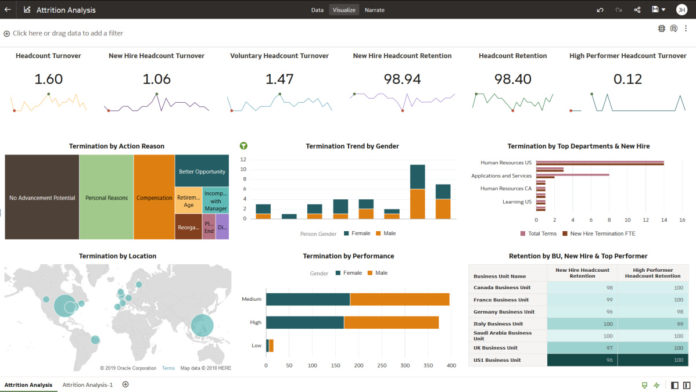
Oracle added new features to Oracle Fusion Cloud HCM Analytics in a bid to help employers identify blind spots and use data to help keep employees engaged and growing.
Built on Oracle’s Analytics Cloud and Autonomous Data Warehouse, Oracle Fusion Cloud HCM Analytics delivers analysis and insights that HR can use to understand workforce diversity, slow employee attrition, optimize recruiting, predict retention trends, manage compensation ratios, and analyze data impacting other activities.
.@OracleCloudHCM added features to help employers ID blind spots and use data to build engagement. #HR #HRTech Share on XIn a blog post, Yvette Cameron, senior vice president of global product strategy for Oracle Cloud HCM, said the module’s pre-built analytics expand on the KPIs, metrics and dashboards the company already offers, and will “help customers get started from day one, without coding, integration or data expertise.”
The system can help employers:
- Better Manage Mobility and Performance: HR leaders can identify which employees are ready for their next career move, what roles are of greatest interest to them and how the company can help them achieve their goals. HR can also get an idea of what activities work best to keep people engaged, how that’s connected to retention, and the types of goals that correlate to the highest performance outcomes.
- Recruit, Reward and Retain Highest Performers: HR leaders can compare compensation to other data including payroll, financial growth and employee performance. This allows organizations to optimize their workforce costs, reward high performers and increase retention. In addition, access to recruiting insights allows employers to leverage Oracle Recruiting Cloud to improve hiring strategies.
- Identify Skills Gaps and Help Employees Grow: The data tools expand on the capabilities of Oracle Dynamic Skills to help leaders understand the talents already present within their workforce. In turn, that allows them to identify internal and external candidates with the right abilities for new roles, and also identify areas they need to hire for.
“We have expanded capabilities, enhancing our Fusion Analytics Warehouse to help give organizations greater insight into their talent,” Cameron said in an interview. “I think it’s especially important now, given the challenges of the Great Resignation and trying to attract people back to the organization, to retain those individuals, to ensure their engagement, et cetera.”
Oracle expanded the KPIs, insights and analytics it delivers through Fusion Analytics Warehouse to offer more than 300 bits of data in areas of performance, compensation, talent and skills that it believes will help drive insights that can directly help organizations in their efforts.
Intelligence and Usability
Oracle also touts the solution’s usability. Users don’t need to know how to, for example, run a report or model data in order to make it work. Analytics are available by voice on any device.
“Fundamentally, I think organizations struggle with accessing and interpreting the data,” Cameron said. The underlying technology of Fusion Analytics Warehouse “enables individuals to more easily access and create those insights and reports that they need to drive better decision-making.”
The Fusion Analytics Warehouse also provides cross-functional analytics and integration with Oracle Fusion Cloud applications for finance, supply chain and HR. That allows users to review, say, revenue and profit by employee or the impact of employee attrition on margins.
Image: Oracle













